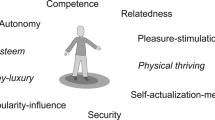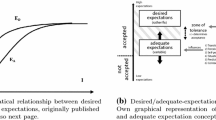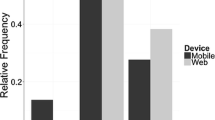Abstract
In this chapter different factors that may influence Quality of Experience (QoE) in the context of media consumption, networked services, and other electronic communication services and applications, are discussed. QoE can be subject to a range of complex and strongly interrelated factors, falling into three categories: human, system and context influence factors (IFs). With respect to Human IFs, we discuss variant and stable factors that may potentially bear an influence on QoE, either for low-level (bottom-up) or higher-level (top-down) cognitive processing. System IFs are classified into four distinct categories, namely content-, media-, network- and device-related IFs. Finally, the broad category of possible Context IFs is decomposed into factors linked to the physical, temporal, social, economic, task and technical information context. The overview given here illustrates the complexity of QoE and the broad range of aspects that potentially have a major influence on it.
Access this chapter
Tax calculation will be finalised at checkout
Purchases are for personal use only
Similar content being viewed by others
Notes
- 1.
Note that the socio-economic aspects are also considered to be part of the CIFs, demonstrating that some factors are very hard to disentangle and categorize. This is reflected in the overlapping areas of IFs in Fig. 4.1.
- 2.
User activity context may be strongly related to task context, for instance when the user tries to achieve a certain goal.
- 3.
References
Qualinet White Paper on Definitions of Quality of Experience — Output version of the Dagstuhl seminar 12181 (2012) In: Le Callet P, Möller S, Perkis A (eds) European network on quality of experience in multimedia systems and services (COST Action IC 1003), Version 1.1, Lausanne
Geerts D, De Moor K, Ketykó I, Jacobs A, Van den Bergh J, Joseph W, Martens L, De Marez L (2010) Linking an integrated framework with appropriate methods for measuring QoE. In: 2010 second international workshop on quality of multimedia experience, pp 158–163
Wechsung I, Engelbrecht K-P, Kühnel C, Möller S, Weiss B (2012) Measuring the quality of service and quality of experience of multimodal human-machine interaction. J Multimodal User Interfaces 6(1–2):73–85. doi:10.1007/s12193-011-0088-y
Jumisko-Pyykkö S (2011) User-centered quality of experience and its evaluation methods for mobile television. Doctoral thesis, Tampere University of Technology, Tampere
Quintero MR, Raake A (2011) Towards assigning value to multimedia QoE. In: Third international, workshop on quality of multimedia experience (QoMEX), pp 1–6
Laghari KUR, Crespi N, Connelly K (2012) Toward total quality of experience: a QoE model in a communication ecosystem. Commun Mag IEEE 50(4):58–65
Wechsung I, Schulz M, Engelbrecht K-P, Niemann J, Möller S (2011) All users are (Not) equal-the influence of user characteristics on perceived quality, modality choice and performance. In: Delgado RL-C, Kobayashi T (eds) Proceedings of the paralinguistic information and its integration in spoken dialogue systems workshop. Springer, New York, pp 175–186
Sackl A, Masuch K, Egger S, Schatz R (2012) Wireless vs. wireline shootout: how user expectations influence quality of experience. In: Fourth international workshop on quality of multimedia experience (QoMEX), 5–7 July 2012, pp 148–149
Burbeck CA, Kelly DH (1980) Spatiotemporal characteristics of visual mechanisms: excitatory-inhibitory model. JOSA 70(9):1121–1126
You J, Xing L, Perkis A, Ebrahimi T (2012) Visual contrast sensitivity guided video quality assessment. In: 2012 IEEE international conference on multimedia and expo (ICME). IEEE, pp 824–829
Greenberg S, Ainsworth WA (2004) Speech processing in the auditory system: an overview. In: Speech processing in the auditory system. Springer, pp 1–62
Goldstein EB (2009) Sensation and perception, 8th edn. Cengage Learning, Wadsworth
Sackl A, Egger S, Zwickl P, Reichl P (2012) The QoE alchemy: turning quality into money. Experiences with a refined methodology for the evaluation of willingness-to-pay for service quality. In: Fourth international workshop on quality of multimedia experience (QoMEX), 5–7 July 2012, pp 170–175
Reiter U (2010) Perceived quality in game audio. In: Grimshaw M (ed) Game sound technology and player interaction: concepts and developments. IGI Global, New York
Rokeach M (1973) The nature of human values. The Free Press, New York
Hassenzahl M (2008) User experience (UX): towards an experiential perspective on product quality. In: Proceedings of the 20th international conference of the association francophone d’interaction homme-machine, ACM Press, New York, pp 11–15
Ryan RM, Deci EL (2000) Intrinsic and extrinsic motivations: classic definitions and new directions. Contemp Educ Psychol 25(1):54–67
Scherer KR (2005) What are emotions? And how can they be measured? Soc Sci Inf 44(4):695–729
Desmet PMA (2002) Designing emotions. Unpublished doctoral dissertation, TU Delft, Delft, The Netherlands
Robert S, John J, Hogan B (1997) Handbook of personality psychology. Academic Press, San Diego
Ghinea G, Chen SY (2003) The impact of cognitive styles on perceptual distributed multimedia quality. Br J Educ Technol 34(4):393–406
Rainer B, Waltl M, Cheng E, Shujau M, Timmerer C, Davis S, Burnett I, Ritz C, Hellwagner H (2012) Investigating the impact of sensory effects on the quality of experience and emotional response in web videos. In: Fourth international workshop on quality of multimedia experience (QoMEX). IEEE, pp 278–283
Arndt S, Antons J-N, Schleicher R, Möller S, Curio G (2012) Perception of low-quality videos analyzed by means of electroencephalography. In: 2012 fourth international workshop on quality of multimedia experience (QoMEX). IEEE, pp 284–289
Reiter U, De Moor K (2012) Content categorization based on implicit and explicit user feedback: combining self-reports with EEG emotional state analysis. In: 2012 fourth international workshop on quality of multimedia experience (QoMEX). IEEE, pp 266–271
Frijda NH (1994) Varieties of affect: emotions and episodes, moods, and sentiments. In: Ekman P, Davidson R (eds) The nature of emotions: fundamental questions. Oxford University Press, New York, pp 59–67
Forgas JP, Bower GH (1987) Mood effects on person-perception judgments. J Pers Soc Psychol 53(1):53
Bless H, Clore GL, Schwarz N, Golisano V, Rabe C, Wölk M (1996) Mood and the use of scripts: does a happy mood really lead to mindlessness? J Pers Soc Psychol 71(4):665
Angrilli A, Cherubini P, Pavese A, Manfredini S (1997) The influence of affective factors on time perception. Percept Psychophysics 59(6):972–982
Higgs B, Polonsky MJ, Hollick M (2005) Measuring expectations: forecast vs. ideal expectations. Does it really matter? J Retail Consum Serv 12(1):49–64
Sackl A et al (2013) Evaluating the impact of expectations on end-user quality perception. PQS workshop 2013, Vienna, Austria
Staelens N, Van den Broeck W, Pitrey Y, Vermeulen B, Demeester P (2012) Lessons learned during real-life QoE assessment. In: 10th European conference on interactive TV and video (Euro ITV-2012). Ghent University, Department of information technology, pp 1–4
Rumsey F, Zielinski S, Kassier R, Bech S (2005) Relationships between experienced listener ratings of multichannel audio quality and naive listener preferences. J Acoust Soc Am 117(6):3832
Speranza F, Poulin F, Renaud R, Caron M, Dupras J (2010) Objective and subjective quality assessment with experts and non-experts viewers. In: Proceedings of the second international workshop on quality of multimedia experience, Trondheim, Norway, pp 46–51
Quintero MR, Raake A (2012) Is taking into account the subjects degree of knowledge and expertise enough when rating quality? In: 2012 fourth international workshop on quality of multimedia experience (QoMEX), IEEE, pp 194–199
De Moor K (2012) Are engineers from Mars and users from Venus? Bridging gaps in quality of experience research: reflections on and experiences from an interdisciplinary journey. Unpublished doctoral dissertation. Ghent University
Radun J, Leisti T, Häkkinen JP, Ojanen HJ, Olives J, Vuori T, Nyman GS (2008) Content and quality: interpretation-based estimation of image quality. ACM Trans Appl Percept 4(4):21:1–21:15
Chen W, Fournier J, Barkowsky M, Le Callet P (2013) New stereoscopic video shooting rule based on stereoscopic distortion parameters and comfortable viewing zone. In: Stereoscopic displays and applications XXII, proceedings of SPIE-IS&T electronic imaging, vol: SPIE, vol. 7863
Zinner T, Hohlfeld O, Abboud O, Hoßfeld T (2010) Impact of frame rate and resolution on objective QoE metrics. In: Proceedings of second international workshop on quality of multimedia experience (QoMEX)
Jammeh E, Mkwawa I, Khan A, Goudarzi M, Sun L, Ifeachor E (2012) Quality of experience (QoE) driven adaptation scheme for voice/video over IP. Telecommun Syst 49(1):99–111
ITU BT.1359: Relative timing of sound and vision for broadcasting
Nahrstedt K, Steinmetz R (1995) Resource management in networked multimedia systems. IEEE Comput 1995:52–63
Fiedler M, Hoßfeld T, Tran-Gia P (2010) A generic quantitative relationship between quality of experience and quality of service. Netw IEEE 24(2):36–41
Brunnström K, Stålenbring D, Pettersson M, Gustafsson J (2010) The impact of transmission errors on progressive 720 lines HDTV coded with H.264. In: Rogowitz B, Pappas TN (eds) Proceedings of SPIE-IS&T human vision and electronic imaging XV, vol 7527, paper 56
Pratsolis D, Tsourakis N, Digalakis V (2007) Degradation of speech recognition performance over lossy data networks. In: Wmunep’07: Proceedings of the third ACM workshop on wireless multimedia networking and performance modeling, pp 88–91
Sackl A, Seufert M, Hoßfeld T (2013) Asking costs little? The impact of tasks in video QoE studies on user behavior and user ratings. In: PQS workshop 2013. Vienna, Austria
Tavakoli S, Gutiérrez J, García N (2013) Quality assessment of adaptive 3D video streaming. In: Three-dimensional image processing (3DIP) and applications. Burlingame, California, USA. 03 Feb 2013, vol Proc. SPIE 8650
Klompenhouwer MA (2006) Flat panel display signal processing: analysis and algorithms for improved static and dynamic resolution. PhD thesis, Technische Universiteit Eindhoven, The Netherlands
Kaptein R, Kuijsters A, Lambooij M, IJsselsteijn WA, Heynderickx I (2008) Performance evaluation of 3D-TV systems. In: Proceedings of SPIE Image quality and system performance V, vol SPIE 6808, p 680819
Lambooij M, IJsselsteijn W, Heynderickx I (2009) Visual discomfort and visual fatigue of stereoscopic displays: a review. J Imaging Sci Technol 53(3):030201-1–030201-14
Wang K, Barkowsky M, Brunnström K, Sjöström M, Cousseau R, Le Callet P (2012) Perceived 3D TV transmission quality assessment: multi-laboratory results using absolute category rating on quality of experience scale. IEEE Trans Broadcast 58(4):544–557
Woods AJ, Docherty T, Koch R (1993) Image distortions in stereoscopic video systems. In: Proceedings of SPIE volume 1915 stereoscopic displays and applications IV, pp 36–48
Patterson R (2009) Review paper: human factors of stereo displays: an update. J Soc Inf Display 17(12):987–996
Gartner: Gartner says worldwide mobile phone sales declined 1.7 percent in 2012
Su J-H, Yeh H-H, Yu PS, Tseng VS (2010) Music recommendation using content and context information mining. Intell Syst IEEE 25(1):16–26
Song S, Moustafa H, Afifi H (2012) Advanced IPTV services personalization through context-aware content recommendation. IEEE Trans Multimedia 14(6):1528–1537
Adomavicius G, Tuzhilin E (2005) Toward the next generation of recommender systems: a survey of the state-of-the-art and possible extensions. IEEE Trans Knowl Data Eng 17(6):734–749
Chen Y-C, Huang H-C, Huang Y-M (2009) Community-based program recommendation for the next generation electronic program guide. IEEE Trans Consum Electron 55(2):707–712
Qi X, Davison BD (2009) Web page classification: features and algorithms. ACM Comput Surv 41:1–31
Yu Z, Zhou X, Yu Z, Zhang D, Chin C-Y (2006) An OSGi-based infrastructure for context-aware multimedia services. Commun Mag IEEE 44(10):136–142
Jumisko-Pyykkö S, Vainio T (2010) Framing the context of Use for mobile HCI. Review paper about mobile contexts of use between 2000–2007. Int J Mob Hum Comput Interact (IJMHCI) 3(4):1–28
Bradley NA, Dunlop MD (2005) Toward a multidisciplinary model of context to support context-aware computing. Hum Comput Interact 20(4):403–446
Roto V (2006) Web browsing on mobile phones: characteristics of user experience. Doctoral dissertation, TKK Dissertations 49, Helsinki University of Technology, Helsinki, Finland
Väänänen-Vainio-Mattila K, Ruuska S (2000) Designing mobile phones and communicators for consumers’ needs at nokia. In: Bergman E (ed) Information appliances and beyond: interaction design for consumer products, Morgan Kaufmann, Morgan Kaufmann
Wigelius H, Väätäjä H (2009) Dimensions of context affecting user experience in mobile work. In: Proceedings of INTERACT 2009, Aug 2009, Uppsala, Sweden
Korhonen H, Arrasvuori J, Väänänen-Vainio-Mattila K (2010) Analysing user experience of personal mobile products through contextual factors. In: International conference on mobile and ubiquitous multimedia. Limassol, Cyprus
Rahman MA, El-Saddik A, Gueaieb W (2011) Augmenting context awareness by combining body sensor networks and social networks. IEEE Trans Instrum Measur 60(2):345–353
Möller S, Engelbrecht K-P, Kühnel C, Wechsung I, Weiss B (2009) A taxonomy of quality of service and quality of experience of multimodal human-machine interaction. In: International workshop on quality of multimedia experience, pp 7,12, 29–31
Zhou L, Xiong N, Shu L, Vasilakos A, Yeo S-S (2010) Context-aware middleware for multimedia services in heterogeneous networks. Intell Syst IEEE 25(2):40–47
You S, Neumann U (2005) V-sentinel: a novel framework for situational awareness and surveillance. Proc SPIE 5778(713):713–724
Wang Y, Krum DM, Coelho EM, Bowman DA (2007) Contextualized videos: combining videos, with environment models to support situational understanding. IEEE Trans Vis Comput Graph 13(6):1568–1575
Borowiak A, Reiter U, Svensson UP (2013) Audio quality requirements and comparison of multimodal vs. unimodal perception of impairments for long duration content. J Sig Process Syst, May 2013. doi:10.1007/s11265-013-0777-8
Hong J, Suh E-H, Kim J, Kim SY (2009) Context-aware system for proactive personalized service based on context history. Expert Syst Appl 36(4):7448–7457
Reynolds G, Barry D, Burker T, Coyle E (2008) Interacting with large music collections: towards the use of environmental metadata. In: Proceedings of IEEE Int’l conference on multimedia and expo, pp 989–992
Cardone G, Corradi A, Foschini L, Montanari R (2012) Socio-technical awareness to support recommendation and efficient delivery of IMS-enabled mobile services. Commun Mag IEEE 50(6):82–90
Chakareski J, Frossard P (2010) Context-adaptive information flow allocation and media delivery in online social networks. IEEE J Sel Top Sig Process 4(4):732–745
Reiter U, Weitzel M, Cao S (2007) Influence of interaction on perceived quality in audio visual applications: subjective assessment with n-back working memory task. In: Proceedings of AES 30th international conference. Saariselkä, Finland
Reiter U, Weitzel M (2007) Influence of interaction on perceived quality in audio visual applications: subjective assessment with n-back working memory task, II. In: AES 122nd convention. Vienna, Austria. Preprint 7046
Reiter U, Weitzel M (2007) Influence of interaction on perceived quality in audiovisual applications: evaluation of cross-modal influence. In: Proceedings of 13th international conference on auditory displays (ICAD). Montreal, Canada
Pashler HE (1999) The psychology of attention. 1st paperback edition, The MIT Press. Cambridge, MA, USA. ISBN 0-262-66156-X
Acknowledgments
Katrien De Moor’s work was carried out during the tenure of an ERCIM “Alain Bensoussan” Fellowship Programme and received funding from the European Union Seventh Framework Programme (FP7/2007-2013) under grant agreement no 246016.
Author information
Authors and Affiliations
Corresponding author
Editor information
Editors and Affiliations
Rights and permissions
Copyright information
© 2014 Springer International Publishing Switzerland
About this chapter
Cite this chapter
Reiter, U. et al. (2014). Factors Influencing Quality of Experience. In: Möller, S., Raake, A. (eds) Quality of Experience. T-Labs Series in Telecommunication Services. Springer, Cham. https://doi.org/10.1007/978-3-319-02681-7_4
Download citation
DOI: https://doi.org/10.1007/978-3-319-02681-7_4
Published:
Publisher Name: Springer, Cham
Print ISBN: 978-3-319-02680-0
Online ISBN: 978-3-319-02681-7
eBook Packages: EngineeringEngineering (R0)




